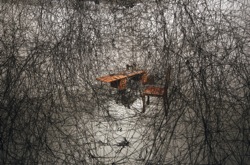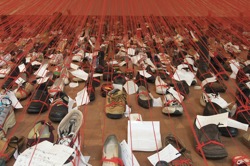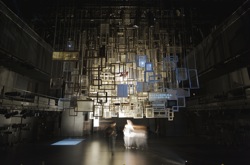Chiharu Shiota (artist, born 1972 in Osaka. Currently based in Berlin)

Unconscious Anxiety Shiseido Gallery, Tokyo
photo: Sunhi Mang
Okabe: You have been producing a number of art events and performances
which feature the use of the body. Does the inspiration for using the
body for art come from your experience of learning under Marina Abramovie
Shiota: Yes, I suppose so. Originally, however, I sent my portfolio to
Magdalena Abakanowicz asking to study under her because I was moved by
the exhibition in Japan I saw of hers when I was 19. A reply, however,
came from Marina Abramovi? instead. By this odd incident I came to study
under Marina Abramovi? for about 2 years. Since then I have been living
in Germany for 13 years and we are still in contact.
Okabe: Marina Abramovi? is well-known for her performances and for her
image works in which she pushes her body to the limit. I believe that it
must be quite tough to train under her.
Shiota: It sounds quite unbelievable in Japan but we trained by fasting!
The fasting itself was for a week and it was a training in which we
experienced something that was very valuable and also something very
different from our daily lives.
On the morning of the 7th day of fasting, which I do not remember much
about since it was so dark, Marina Abramovi? came to my bedside, gave me
a paper and pencil, and told me to "Write whatever comes into your mind.
" I had not eaten in 7 days and I was barely conscious. All I could think of was the word "
Japan". After I wrote that word, she told me that "This word (Japan)
came out from you so you should think what it means. This could be a
very important theme for your art work."
After the fasting, we were given an assignment to create an art
work according to the word we had written on the paper. I do not know
why I had written "Japan" but I nevertheless created an art work about
my feelings toward Japan. I dug a hole in a cliff in which I rolled,
naked, in and out of the hole, again and again. I kept rolling back into
the hole because I missed being there. When you live overseas, which for
me meant living in Germany, there are times when I have strong feelings
of nostalgia for Japan. This nostalgia could be caused by missing
Japanese food, friends or family but mostly it is vague. When I actually
go back to Japan, I sometimes think to myself "Was it really like this
before?" which causes me to feel that whatever I thought I may have
missed does not exist anymore. I feel troubled by this gap between
reality and what I thought I felt nostalgic for. It is like an old pair
of shoes that do not fit you anymore. This theory inspired me to do the
Shoe Art Piece for the National Museum of Art, Osaka. For that art work,
I requested people in Osaka to send me their old, unneeded shoes with
messages or episodes about them. I advertised on posters, radio and on
the internet. In the end, I gathered 2,000 pairs of shoes.


『Over the Continents』National Museum of Art installation in 2008 (Osaka)
photo: Sunhi Mang
Okabe: Has living in Germany made you feel like an outsider since
Germany has a dark past of Nazism? Also, since Japan and Germany
are two countries that lost World War II, does it make you feel like the
two countries are related in some sense? Or does living in Germany
itself have some kind of other influence on you and your work?
Shiota: In my case, I did not wish to live in Germany but have come to
live here by coincidence. I first wished to study under Magdalena
Abakanowicz but I made the mistake for sending a letter to Marina
Abramovi?, which lead me to living in Germany rather than Poland. Since
then, by living in Germany for 13 years, I can see what I could not have
seen if I lived in Japan. For instance, when you put salt water on a
plate and leave it, the water evaporates leaving behind salt visible as
crystals. When I was living in Japan, I did not see myself as an
individual. I did not know what sort of being I was in the water and
what I needed, or wanted to do. By living in Germany I became an
individual. I became crystallized. If you think of it this way, then
living in Germany has provided me with a good working environment as an
artist.
Okabe: You had an exhibition in the 21st Century Museum of Contemporary
Art, Kanazawa called ”A Hundred Stories about Love” for which you used 1,
000 window frames (it has since been purchased by the Museum and is now
permanently exhibited). Another 200 window frames are used by the
National Theatre for a play called "Tattoo" which is directed by Toshiki
Okada who is the leader of the acting troupe Chelfitsch. How was the
experience of doing your first stage design in Japan?

stage design for "Tattoo" New National Theatre Tokyo photo: Sunhi Mang
Shiota: For this stage design, I dangled the window frames in mid-air.
In Mr. Okada's works, there is a lot of attention paid to the gap
between the words and gestures in conversations, just as in how my
speech and hand movements are not at all related. I deliberately tried
to show a glimpse of Mr. Okada's theory on stage. I tried to show the
gap between the words and gestures that are being performed naturally on
stage. Speaking of my work, I especially focus on the existence of
absence. However, in plays actors cannot create absence so easily
because they need to be on stage. I had a very hard time trying to
perfect the stage design. During my thinking process for the design, I
finally came to understand that Mr. Okada's theory on the gap between
words and gestures is the important element to my creating art. Mr.
Okada's and my own work are opposite extremes, however, we are
ultimately seeking the same thing. When I was working I thought that Mr.
Okada's works are like going up and down a spiral staircase. The middle
of the stairs represents the desire and the truth of wanting to express.
Still, you have to go up and down that feeling and desire for expression
in order to get closer to the middle of the stairs. I try to express
that through my art work but in the end, art, theater, music and
literature are all aiming for the same, even though the methods used for
expression are different.
Okabe: I also feel that Mr. Okada is trying to eliminate all theater
jargon - he aims to erase all what we have learnt. In general, we pile
up new knowledge on top of what we have already learnt. Eliminating that
base of knowledge is somewhat scary and impossible. Looking at your
works, it seems you create your own jargon for each material which is an
absolutely different method but somehow seems really close to Mr.
Okada's idea.
Shiota: Speaking about materials, I do not want to create or show off
each material in my art work. My art work mostly involves materials with
a previous owner who I cannot see but the material still attracts me in
its present condition. My job is to create and express. I cannot
deliberately create or dress things up. I feel like an alien when I work
like that and I also do not want to see other people working like that.
It feels like I have been lied to. This philosophy is probably what I
have in common with Mr. Okada.
This talk was taken on the 10th of May 2009 at Shiseido Building in the occasion of the exhibition of the 6th Tsubaki-kai [Trans-figurative] held at the Shiseido Gallery in 2009. (translated by Miki Murata)
塩田千春 1972年大阪生まれ、ベルリン在住
塩田千春×岡部あおみ
『無意識の不安』「椿会展2009 Trans-Figurative」 資生堂ギャラリー(東京)photo: Sunhi Mang
岡部:身体を使ったアクション、パフォーマンスをいくつかやっていらっしゃるんですけども、身体と自分自身の作品との関わりには、若い頃にドイツの大学で指導を受けたマリーナ・アブラモヴィッチからの刺激もあったのでしょうか。
塩田:あったと思います。一番最初はマグダレーナ・アバカノヴィッチに習いたくて手紙を書きました。彼女の個展を19歳の時に日本で観てすごく感動したのです。この先生のもとで勉強したいと思い、資料を送ったら、返事が来たのが マリーナ ・アブラモヴィッチだったんです。という偶然から、マリーナ・アブラモヴィッチの元で勉強することになったのです。結局それ以来ドイツに13年滞在していて、今もコンタクトはありますが、マリーナのところで勉強したのは約2年ぐらいでした。
岡部:マリーナはパフォーマンスと映像作品で著名な作家ですが、彼女自身も身体を限界まで持って行く厳しいパフォーマンスが多いので、彼女のもとで勉強すると、その学習自体もものすごく厳しいと聞いています。
塩田:日本では考えられないと思うのですけど、断食修行がありました。断食自体は一週間くらいで、毎日が普段の生活とはかけ離れた行為をするすごく貴重な授業でした。断食してちょうど7日目の朝、真っ暗だったんで何時か解らなかったんですけど明け方に彼女が枕元にやってきて「なんでもいいから一言書きなさい」と鉛筆と紙を渡すのです。私は7日間も食事をしていないうえ、凄く朦朧としていて何も書けなくて、ただ思い浮かんだのが「Japan」だったんです。その後、彼女に「これは、あなたの中から出て来た言葉だからこれが何なのか考えること、そして、これは作品を作る上で重要なテーマになるだろう。」と言われました。
今度はその言葉についての作品をつくる課題が出されました。私は「Japan」と書いてしまったので、その時は何故「Japan」という言葉が出て来たのか解らなかったのですが、そのときの日本に対する気持ちを作品にしました。崖に穴を掘って裸で横たわってゴロゴロっと転げ落ちながら、でも転げ落ちるとまた穴が恋しくなってその穴に戻ろうとする。海外に住んでドイツで生活していると日本がすごく恋しくなるときがあるのです。でも恋しいのは日本食であったり、友達だったり、両親だったり、と漠然と形にならないものですが、実際の日本に帰って見るとその恋しかったものが、あれ?こんな感じだったかしらと思うことがあり、それがどこにもないような気持ちにさせられるのです。私は一体何が懐かしかったのだろうと、そのギャップに戸惑ってしまうのです。 昔の靴が足のサイズが一緒なのに合わなくなったような感じです。その靴の感覚が、大阪の国立国際での靴の作品に繋がりました。大阪では展示のために一般の人から、要らなくなった靴にメッセージや思い出などを添えて送ってくださいと、広告、ラジオ、インターネットなどで、美術館から募集して2000足の靴を集めた作品です。
岡部:ドイツでずっと生活してきた中で、戦争中にナチズムなどの歴史の闇を背負った国ですし、そこでの異邦人の生活という意味での境界線を感じるとか、あるいはドイツと日本は同じ敗戦国なので近い部分があるとか、ドイツで活動していくことで、塩田さんの作品に大きな影響を与えている要素はあるのでしょうか。
塩田:私の場合ドイツで生活したいという欲求が元々あったわけではなく、名前は間違えたけれども、マグダレーナ・アバカノヴィッチに学びたいという理由でポーランドではなく、たまたまドイツでの生活が始まり、その後13年間も異文化で暮らしてきました。ドイツにいると日本では見えなかった自分がもっと見えてくるような気がするのです。たとえば塩水をお皿の上においていると、蒸発して塩だけが残ってくる。塩水では、見えなかったその塩が見え今度は結晶になっていく。日本にいる時は自分は個としては見えてこなかった。水の中で自分がどういう存在なのか、何をやりたいのか、何が必要なのかがわかりにくかったのがドイツに来て個となり結晶となり、初めて見えて来たように思います。そんなことを考えると作家としてドイツで制作することは私にとってはとてもやり易いことでした。
岡部:金沢21世紀美術館で開催されている『愛についての100の物語』という展覧会に展示されている1000枚の窓枠を使ったインスタレーション作品を購入し、今も展示しているんですね。それ以外の残りの200個の枠は、現在新国立劇場の小劇場で、劇団チェルフィッシュのリーダーの岡田利規さんの演出で、『タトゥー』という演劇が始まり、そこの舞台美術に使用されていると伺いました。日本での舞台美術は初めてだと思いますが、いかがでしたか。
塩田:今回の舞台で窓枠を家の形に空中につってみました。 岡田さんの作品のなかで、よく身体と言葉のズレがテーマに出てくるのですが、それは、たとえば私が今こうして話している言葉と手の動きには全く関係ないことがある。それをあえて舞台の上で動作と言葉を合わせて演じることによって故意に垣間見せてしまう。あえて身体と言葉をずらしたまま自然に演技をする。 私の作品は不在の中の存在感を特にテーマにしているので、役者という存在がいると不在になりえないわけなのです。そこでどのようしてこの舞台美術を完成しようかと悩みました。悩みながら、彼がやっている言葉と演技のズレは、私が作品を作る上でもとても重要な要素なのだと気が付いたのです。岡田さんと私の仕事は両極端に見えながらも、求めていることは、実は同じなのではないかと思えてきました。仕事をしていて思ったんですけど、彼の作品は螺旋階段の周りを登ったり降りたりしている作品だと思いました。真ん中に自分が表現したい真実という中心があり、その周りを行ったり来たりしているのです。登ったり降りたり何度も繰り返しながら確実に真実に近づいていく。しかもズレながら。私は美術でそれを表現しようとしていますが、結局のところ、美術も演劇も音楽も文学も、表現方法は違っても求める世界は一緒なのですね。
岡部:彼も現在、既存の舞台言語を0にするところから出発している感じがします。今まで学んで来たことを一度はまず捨てて表現しなさいと言うんだけど、これはなかなか難しい。みんな普通は一度構築したものにまたさらに新しいものを重ねようとやっていきますから、いきなりそれを全部壊すのは怖いしできない。塩田さんの作品を見ていて、素材に対して一つひとつ丁寧に新たな造形言語を作っていく手法が彼とは逆でもかなり近いと感じますね。
塩田:マテリアルについては、できるだけ作ったり虚飾したくないですね。どの作品の素材もその人が使っていたもので、その人の存在が見えないのだけれど、見えてくる素材に惹かれるのです。何かを作ること、表現することを職業としている中で、一番できないのがわざと作ったり着飾ったり、そういう仕事をしていると嘘を付いているような気がして、またそういう作品を見ると嘘をつかれたような気がして面白くない。そこもまた岡田さんと共通する部分だと思います。
このトークは資生堂ギャラリーで開催された「第六次「椿会」展Trans-Figurative」2009年の会期中に資生堂ビルで行われた。翻訳:村田美樹
